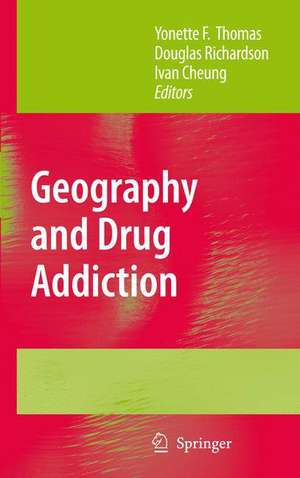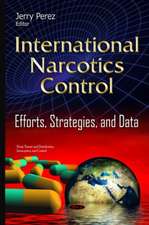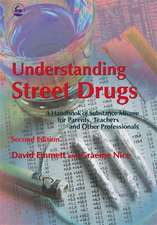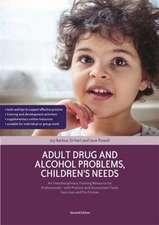Geography and Drug Addiction
Editat de Yonette F. Thomas, Douglas Richardson, Ivan Cheungen Limba Engleză Hardback – 7 oct 2008
Preț: 968.65 lei
Preț vechi: 1181.28 lei
-18% Nou
Puncte Express: 1453
Preț estimativ în valută:
185.34€ • 193.54$ • 153.06£
185.34€ • 193.54$ • 153.06£
Carte tipărită la comandă
Livrare economică 15-29 aprilie
Preluare comenzi: 021 569.72.76
Specificații
ISBN-13: 9781402085086
ISBN-10: 1402085087
Pagini: 300
Ilustrații: 300 p.
Dimensiuni: 155 x 235 x 28 mm
Greutate: 1.11 kg
Ediția:2008
Editura: SPRINGER NETHERLANDS
Colecția Springer
Locul publicării:Dordrecht, Netherlands
ISBN-10: 1402085087
Pagini: 300
Ilustrații: 300 p.
Dimensiuni: 155 x 235 x 28 mm
Greutate: 1.11 kg
Ediția:2008
Editura: SPRINGER NETHERLANDS
Colecția Springer
Locul publicării:Dordrecht, Netherlands
Public țintă
ResearchCuprins
Placing Substance Abuse.- Integrating Geography and Social Epidemiology in Drug Abuse Research.- Integrating GIS into the Study of Contextual Factors Affecting Injection Drug Use Along the Mexico/US Border.- The Spatial Context of Adolescent Alcohol Use*.- Migration Patterns and Substance Use among Young Homeless Travelers.- Residential Mobility and Drug Use Among Parolees in San Diego, California and Implications for Policy.- Social Disorganization, Alcohol, and Drug Markets and Violence*.- Integrated Assessment of Addiction Epidemiology in Hong Kong, 1996–2005.- Residential Segregation and the Prevalence of Injection Drug Use among Black Adult Residents of US Metropolitan Areas.- The Relationship of Ecological Containment and Heroin Practices.- Comparing Unintentional Opioid Poisoning Mortality in Metropolitan and Non-Metropolitan Counties, United States, 1999–2003.- Spatial Patterns of Clandestine Methamphetamine Labs in Colorado Springs, Colorado.- A Therapeutic Landscape? Contextualizing Methamphetamine in North Dakota.- Are Spatial Variables Important? The Case of Markets for Multiple Drugs in British Bengal.- Human Immunodeficiency Virus (HIV) Infection Rates and Heroin Trafficking: Fearful Symmetries.- Metropolitan Area Characteristics, Injection Drug Use and HIV Among Injectors.- Factors Influencing Drug Use and HIV Risk in Two Nicaraguan Cities.- Drug Use and HIV/AIDS: Risk Environments in Post-Soviet Russia.- Substance Abuse and HIV in China.- Placing the Dynamics of Syringe Exchange Programs in the United States.- The effect of individual, program, and neighborhood variables on continuity of treatment among dually diagnosed individuals.- Exploring the Reciprocal Effects of Substance Abuse Treatment Provision and Area Substance Abuse.- Using a GISFramework to Assess Hurricane Recovery Needs of Substance Abuse Center Clients in Katrina- and Rita-Affected Areas.- Using GIS to Identify Drug Markets and Reduce Drug-Related Violence.- Modeling the Spatial Patterns of Substance and Drug Abuse in the US.- Reconceptualizing Sociogeographic Context for the Study of Drug Use, Abuse, and Addiction.- Spatial Analytic Approaches to Explaining the Trends and Patterns of Drug Overdose Deaths.
Textul de pe ultima copertă
The research in this book on the geographical context of drug addiction contributes to better understanding the etiology of addiction, its diffusion, its interaction with geographically variable environmental, social, and economic factors, and the strategies for its treatment and prevention. This book explores links between geography and drug abuse and identifies research ideas, connections, and research pathways which point to some promising avenues for future work in this area.
The topics explored in Geography and Drug Addiction include:
The topics explored in Geography and Drug Addiction include:
- Spatial patterns of drug use and addiction
- Linking spatial models with drug abuse research
- Interaction of social and environmental factors with biochemical processes of addiction
- Locational analyses of drug addiction treatment and service delivery facilities
- Neighborhood scale studies of geographic factors (including the built environment) and their interaction with drug addiction, treatment, or prevention
- Use of Geographic Information Systems (GIS) to better understanding and respond to drug addiction
- Spatial diffusion modeling of addictive drug usage and its changing characteristics, including also predictive modeling
- Social epidemiology and GIS
Caracteristici
The only book focused on the intersection of geography and drug abuse research Multidisciplinary chapters combining the methodologies of both social and physical sciences These unique mixed-methodological approaches move beyond more traditional research in the field of drug abuse and provide fresh perspectives











